|
FAQs about Marine Worms, Vermiform Animals
Identification 17
Related FAQs: Worm
IDs 1, Worm IDs 2, Worm IDs 3, Worm
IDs 4, Worm IDs 5, Worm IDs 6, Worm
IDs 7, Worm IDs 8, Worm IDs 9, Worm
IDs 10, Worm ID 11, Worm ID 12, Worm ID
13, Worm ID 14, Worm ID 15, Worm ID
16, Worm ID 18, See
Also: Flatworm ID 1 +,
Nemertean, Proboscis, Ribbon Worm ID
1, Nematode, Roundworm ID
1, Nematomorpha, Horsehair Worm ID
1, Acanthocephalans, Thorny-headed Worm ID
1, Tubeworm/Featherduster ID
1 +, Bristle Worm ID 1 +,
Hirudineans, Leech ID 1, Sipunculids, Peanut Worm ID 1, Echiuran Worm ID 1, Invertebrate Identification, Worms 1, Worms 2,
Worms 3, Flatworms/Planaria, Fire/Bristleworms, FAQs on: Worm Behavior, Worm
Compatibility, Worm Selection,
Worm Systems, Worm Feeding, Worm
Disease, Worm
Reproduction,
Related Articles: Worms,
Featherduster Worms,
|
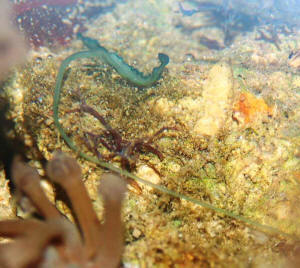
|
Unknown Anemone, and pest spag. worm Qs
11/18/11
Good Evening!
I have an anemone that I am unsure of its name. It's smaller than
my Zoanthids it came attached to.
<Mmm... maybe just a juvenile>
It has a bright red foot with clear bubble-like tentacles. I checked
out all the articles that looked promising and a Magnificent anemone
seems the most fitting. But I am wondering if it is possible for one to
be so small and survive being transported with the zoos.
<Yes; is possible>
It doesn't attack the zoos
<Unusual that they're not competing chemically. May be the
reason the odd animal is so small... I would excise it (with a single
edged razor blade or such) and move it to another Cnidarian-free
area>
at all but when the current moved it up
<?>
under a stalk xenia the anemone quickly grabbed onto a single tentacle
and sorted of pinched it. The tentacle of the xenia seems to be
recovering. Is this a pest or just one I should treat as any other
anemone?
<Can't tell from what is offered here. Do send along a couple of
well-resolved images, your further observations when you can>
On another note, I have a worm which appears to have a calcareous shell
but no crown. I wouldn't be concerned accept <except> that it
sends out a spider web looking string that has gotten on a colony of
zoos. I pulled it off gently since it couldn't be good covering the
colony.
<Not to worry. Leave the strands alone>
Is this a good or bad worm? I can easily move it somewhere where the
web-like strings will not reach if the worm is beneficial.
<I'd leave this (spaghetti) worm alone. See WWM (the search
tool) re>
Thank You so much for such wonderful information here!!!!
<Welcome! Bob Fenner>
|
An alarming number of Skinny white
worms with lots of legs. Marine 8/19/11
I just recently inherited a very badly kept tank. The water
levels were off and all the coral was dead from being left out.
I've been working on it for a very long time now and finally
got the water balanced and lighting correct. As of yesterday I
added the regular nitrate and nitrite detoxifying formula.
<What is this? You should not have to do this with adequate
filtering and water changes.>
My fish started acting weird, running into things and I swear it
went blind. I left it alone with the lights off over night and
when I turned the light on the next day he was fine other than
breathing hard. I was observing the tank and found curly looking
dried worms stuck to the inside back wall where my filtration
system is. Its kinda hard to describe what they look like so I
included a picture of them.
<Common filter feeders, nothing to worry about. Probably a
species of Vermetid snails or tube worms.>
I originally saw these when I first got the tank and assumed it
was from the coral. Well I don't believe it is anymore. When
I took a closer look I realized one was moving. Its was about 3
inches long skinny white and a pinkish tone to the inside. It
looks like there are tons of legs, there featherish looking.
<This is a bristle worm, a scavenger. Common and usually
harmless to beneficial unless very large. Do not try to touch it
to remove it, it possesses painful barbs. http://www.wetwebmedia.com/polychaeidfaqs.htm
.>
I'm not sure if the strange behavior has to do with anything
but I tried looking it up on your forum and others for just the
worm type things but found that most peoples were centipede
looking bristle worms and theirs were harmless. Mine resembles a
centipede but a lot skinnier and not colored.
<They come in many shapes, sizes, and colors.>
After researching into it I have found no solid explanations and
when I took a look earlier today I found that there are a crap
load of them all over my rocks. inside and under.
<Favorite spots for the Vermetid snails.>
I also have a Ulva plant than found some in there too. I have no
clue what they are and the number of them is alarming.
<Aquarium life generally suit them well.>
The strange part is those dried parts were not there last night.
I'm just in a panic mode right now!
<They probably were and you just did not notice them
before.>
If it helps I have a 17gal tank and one small sized tomato clown
fish along with a couple Dwarf Cerith & Planaxis.
<This guy will need a larger home. http://www.wetwebmedia.com/TomatoClnsBell.htm
.>
Please Help!!!
Thanks,
Noelani
<Welcome>
<Chris>
|
|
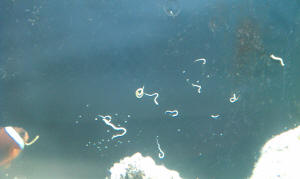 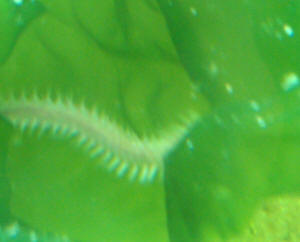
|
hi question of coral worm 5/30/11
Hey I have a question that I've been looking and asking every coral
store to give me an answer or identification. I have a what looks like
a worm outbreak. They have a anchor or foot they attach with small
circular brownish looking, coming out of this is a white tail with
numerous branches resembling a double sided comb.
<Mmm, the "crown" of... a species of Sedentariate
Polychaete?>
The tail extends and retracts. It's isn't until recently the
worm looking creatures have moved onto certain Acropora species and are
starting the stress and kill them. I tried a iodine dip and had no
positive results from it besides stressing my coral further I can send
pictures upon request but please help me and save my
Acroporas'.
<Do please send along some well-resolved images. Bob
Fenner>
strange bacteria... SW... worm ID, 19 Megs...
04/21/11
Hi, Myself Richard of lately I have noticed some strange white
minute worms stuck to the glass of my marine tank please
identify and advice if it is harmful if yes please suggest remedy
Attached a rough sketch snap & clips for ur reference please
advice
Thanks & regards
Richard
<Read here: http://wetwebmedia.com/WormID17.htm
and the linked files above.
Your msg. has been deleted. Your images are too large. Review our
submission standards and re-size, re-send. Bob Fenner>
|
Parasite/Worm ID 3/6/11
I am in need of some assistance,
<Why I'm here>
I have a worm I need to identify. In the span of 3 weeks, I went
from noticing a single whitish-pink 5mm worm in my saltwater
tank, which I quickly removed, to watching in horror as they
reproduced into the thousands. The first one I spotted was about
the size of the smallest worm in the first photo.
The large adults are nearly an inch and a half long now. They
come out at night, and are usually crawling along the glass. I
rarely find them swimming freely, unless I try to capture one, in
which case it will use a distinctive corkscrew type swimming
motion in which to escape. I watch my tank closely, and the
numbers of worms are astounding. The small specks in the photos
below are juvenile worms. The largest worm pictured is about 1
inch in length, and there can be literally 25 to 50 smaller ones
inside a square inch.
Given their explosive rate of reproduction after entry into the
tank, I need to ID them fast! I have spent several days
researching their identity, including all pages of the WormID
featured on your amazing site. They are pinkish-white in color,
crawl freely on the glass at night, and when I grab them out with
forceps, they escape by using a corkscrew swimming motion. I DO
NOT think they are bristle worms. The juveniles pictured below
are 1-2mm in length. I feed my fish lightly and have several
dozen scavenger/janitors in my tank to clear up excess detritus.
The anemones are the only ones that seem to be affected by these
worms. But that is MORE than enough for me.
They have killed two anemones, each showing a "chewed"
appearance only at the base of their foot when they died.
I've never experienced ANY problems with my anemones prior to
the appearance of these worms. After careful examination I
didn't notice any live worms burrowed in the flesh... but who
knows? If these are simply bristle worms, I want them gone. But
it seems like adding even multiple traps would be about as
effective as putting a mouse trap into an ant pile given their
size and number. Water parameters are pristine, as tested by me
and by my LFS. Any help??
Thank you so much for your amazing site!!
<Thank you for your kind words... your excellent images show
this to be some sort/species of Errantiate Polychaete
(Bristleworm)... of the thousands of species possible, I cannot
tell you much more than this... We can possibly get this ID to
family w/ some growth details of the head region. Not parasitic,
at any length though, if these are not bothering anything much,
I'd leave them be. Bob Fenner>
-Mark H.
|
|
 
|
|
worm? 3/1/11
Hey guys! Might be a rhetorical question and if it is, I'm
sorry. I attached a picture of what I think is a spaghetti
worm...?? If so, I've read on your site that they're good
to have and I have maybe 1000 in my 46 gallon tank that is just
housing them along with seasoned live sand...... moved everything
else to a 150.
Thanks for the info ahead of time!
Tammy
<Does appear to be part of the cephalic end of a Terebellid.
Bob Fenner>
|
|
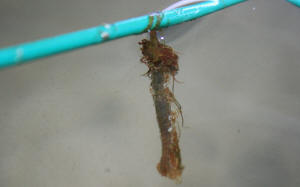
|
|
Mysterious Worm: Cirratulid/Hair Worm --
1/15/11
Hey WWM Crew,
<Hey there, Lynn here today.>
I am currently stationed overseas in Japan and decided to start a
saltwater aquarium
<Neat!>
...and recently I found this mysterious worm in my 30 gallon
tank. I noticed it when I was cleaning out some of the sand
because I noticed a red algae growing under the sand along the
glass.
<Sounds like BGA/Blue Green Algae/Cyanobacteria. Please see
the following link (as well as related links at the top of the
page) for more information: http://www.wetwebmedia.com/bluegralgae.htm
>
When I went to pick up my live rock I noticed two reddish thready
balls hanging onto the bottom of it. I set my live rock in
quarantine and noticed that the balls were moving. After about 5
minutes one unraveled to reveal a 3-4 in thread like worm. This
worm seems not to have a solid body but tiny threads and
tentacles. I have done some research but still can't find
anything on them. Can you help?
<Yep, no worries; you appear to have several harmless
Cirratulids (aka 'Hair Worms'). Most are 2" or less
in body length but the various appendages (two long feeding
tentacles and a number of filament-like gills can add to the
appearance of overall length. Please see the FAQ titled 'Red
Stringy Creature: Likely Cirratulid -- 10/14/09 at the following
link for more information: http://www.wetwebmedia.com/nonvertIDF49.htm?h=
>
Thank you
<You're very welcome. Take care, Lynn
Z><<Ahhh!>>
|
|
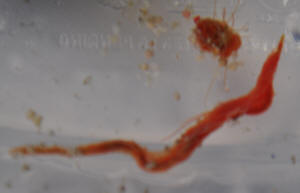
|
|
Worm ID 11/18/10
Hello,
<Hi there>
I found this worm that I could not identify. I attached two macro
photos, the second one is under exposed to try to reveal more
detail on its bright white head.
<Is there a "sucker" there? Other observable
processes?>
It's approximately 7mm long, and as you can see, it's
climbing the glass. I originally found it on one of my
rocks, but I accidentally knocked it into the sand where it
buried. It re-emerged near the end of the day to scale the tank,
as you see in the photos.
It doesn't appear to belong to phylum that I'm familiar
with. There's no segmentation or other annelid features,
<Good observation>
and it's not flat like any Platyhelminthes or Acoelomate
worms I've seen. There are a number of
"worm-a-form" phyla <phyla> that I am not
familiar with, so I am a guess that it might belong to one of
those. Thank you for the help! I'm really looking forward to
find out what it is.
Alex
<Mmm, well... the most likely guess is a nematode... perhaps a
Hirudinean... Need (microscopic) examination to be more sure; a
coronal section/cut across the esophagus would be telling... Bob
Fenner>
|
|
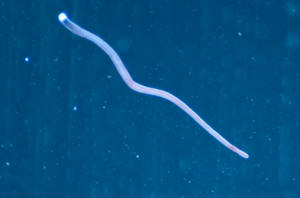 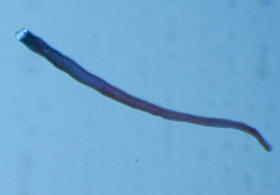
|
|
Long brown worm 11/7/10
This morning we were moving a few rocks around in 375g mainly sps
reef aquarium. We noticed this long brown/black worm on top of
the sand bed.
This aquarium has been set up for 2 years. And some of the live
rock came out of our 2 year old reef tank. We took the worm to
our local fish store and we looked through many books, but we
were unable to id this worm.
<Need better (more highly resolved, better acuity) pix of the
head end. I suspect this is a Holothuroid, not a worm. Bob
Fenner>
|
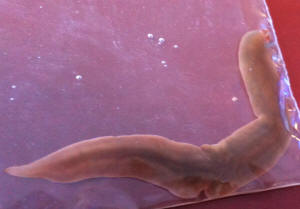
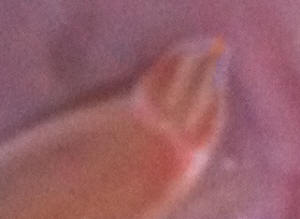 |
Re: Long brow worm
11/8/10
Thank you Bob,
However, we left the worm at the LFS :( sorry we are unable to take
more pictures...
Thanks for all your help.
<Ah, thank you for this follow-up. BobF> |
|
Worm ID 11/07/10
Hi WWM,
<Hello Mike>
Recently I have found an infestation of these worms in my tanks.
I have seen some in my reef, and many more in my refugium. They
appear to be bristle worms to me, which as I understand are not
dangerous for my reef, but I would like to be sure that this
isn't anything worse. Any idea what this critter is?
<A Polychaete of some sort; looks like a Terebellid to me. Bob
Fenner>
Thanks, M
|
|
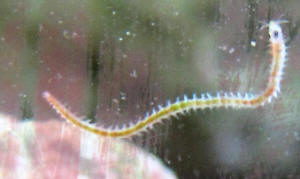
|
|
Mysterious Worm
10/30/10
Good day. I have a worm I am hoping you can help me identify. I
noticed you had a similar photo on your site dated from 2009, but
from what I read it had not been identified yet. From what I can
see the identification was waiting on more photos. Well, here are
some photos of such a worm in my tank. I am hoping these will
help to identify the worm. To give you some idea of scale, the
tank in the photo is a 2.5 gallon ADA Pico. I appreciate
your time and assistance.
Thanks,
Lynn Totten
<Hard to make out, but I think this is a Sipunculid. Read here
re:
http://wetwebmedia.com/pnutwrmidfaqs.htm
Bob Fenner
|
|
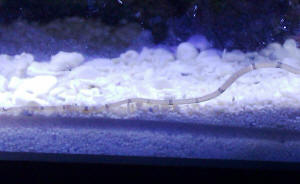
|
|
unidentified organism 10/6/10
Hi guys,
<And gals Karen...>
Been a lurker for years; and finally had occasion to write. You
are absolutely one of the best sources of info for saltwater
enthusiasts of all levels (oh wait, you already know that).
You¹re definitely my go-to guys
when I need to learn something aquatic.
I have maintained saltwater tanks for over 20 years now.
Currently have a micro-reef setup (the Red Sea Max 130D
retrofitted with a Nano Tunze skimmer) that I will eventually use
as a seahorse tank (RSM has the benefit of being able to turn off
one of the pumps to limit the flow).
<Ah yes>
Have added some soft corals and a pistol shrimp/watchman goby
pair (too much fun to watch!) and am finishing a seahorse
training course through Ocean Rider (they aqua-farm seahorses in
Hawaii) before I purchase a few H. erectus.
In the meantime, I am thoroughly enjoying the tank (recent pic
attached). I was sitting in front of it the other night (blue LED
moon lights on) when I noticed something stretched almost across
the tank horizontally, and stretched very taught. I thought
perhaps somehow a hair had gotten in the tank. I shined a light
on the object to try to identify it and it went ... zziiiiippppp,
all the way back across the tank and into a rock.
Now I¹ve seen some stranger critters over the years
that hitchhiked their way into my tank (some of my favorites
things came that way), but this one beats them all. Thinking it
was a worm of some sort, I tried researching along those lines
which just made me conclude that it may not be a worm. But looks
like a worm, acts like a worm, stretches like a worm, so...??? In
any case, I thought I would try you guys for help.
I¹ve attached a couple of pics. They were taken at
night (the only time it surfaces, and definitely not a happy
camper if I try to look at it with a small flashlight). By the
night I took these, it had moved its location to a few rocks down
from the first I saw it in. The first pic is a labeled view of it
stretched vertically across a lot of rock, and the second and
third ones are close-ups of its head. I¹ve never seen
such a wavy head on a worm.
It¹s certainly got me scratching my head. Any
ideas?
Thanks muchly,
Karen
<Mmm, my guess is that this is a Nemertean... a ribbon worm...
Am sending over to LynnZ for her input. Bob Fenner>
|
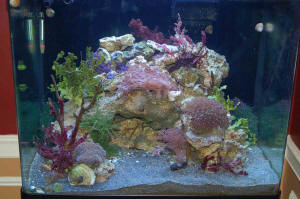 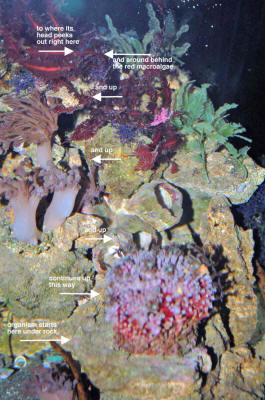
 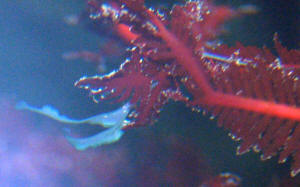 |
|
Follow-up Re: Unidentified Organism -- Bonellid
Echiuran 10/6/10
Hi guys,
<Hi Karen, Lynn here today.>
Been a lurker for years; and finally had occasion to write. You
are absolutely one of the best sources of info for saltwater
enthusiasts of all levels (oh wait, you already know that).
You¹re definitely my go-to guys when I need to learn
something aquatic.
<That's great to hear/read, thank you!>
I have maintained saltwater tanks for over 20 years now.
Currently have a micro-reef setup (the Red Sea Max 130D
retrofitted with a Nano Tunze skimmer) that I will eventually use
as a seahorse tank (RSM has the benefit of being able to turn off
one of the pumps to limit the flow). Have added some soft corals
and a pistol shrimp/watchman goby pair (too much fun to watch!)
and am finishing a seahorse training course through Ocean Rider
(they aqua-farm seahorses in Hawaii) before I purchase a few H.
erectus.
In the meantime, I am thoroughly enjoying the tank (recent pic
attached). I was sitting in front of it the other night (blue LED
moon lights on) when I noticed something stretched almost across
the tank horizontally, and stretched very taut. I thought perhaps
somehow a hair had gotten in the tank. I shined a light on the
object to try to identify it and it went ...zziiiiippppp, all the
way back across the tank and into a rock. Now I¹ve
seen some stranger critters over the years that hitchhiked their
way into my tank (some of my favorites things came that way), but
this one beats them all.
<These are odd-looking little guys, for sure.>
Thinking it was a worm of some sort,
<Yep, it's a harmless/beneficial deposit and suspension
feeder called a Bonellid Echiuran (aka a 'spoon' or
'sausage' worm). Please see the following links for photo
examples:
http://www.biology.ualberta.ca/courses.hp/zool250/LecOutl-07/Clades/clade05-Protostomia.htm
http://www.melevsreef.com/id/tendril.html
More information here: http://www.wetwebmedia.com/echwrmidfaqs.htm
http://www.ronshimek.com/echiurans.html
>
I tried researching along those lines which just made me conclude
that it may not be a worm. But looks like a worm, acts like a
worm, stretches like a worm, so...???
<It's a worm, of the unsegmented variety, that's a bit
of a mess taxonomically speaking. Depending on where you look,
these neat little creatures are either listed under the phylum
Annelida (segmented worms), class Echiura or Echiuroidea, or in a
phylum all their own: Echiura or Echiurida.>
In any case, I thought I would try you guys for help.
I¹ve attached a couple of pics.
<Thanks, the shot of the anterior portion showing the
distinctive 'T' shape clinched it!>
They were taken at night (the only time it surfaces,
<Typical behavior>
..and definitely not a happy camper if I try to look at it with a
small flashlight).
<That's also typical. Like Sipunculids (peanut worms),
Echiurans have a real problem with flashlights. One thing you
might want to consider is getting a flashlight with a red
filter/lens. They're much better for nighttime observation as
the red doesn't startle the inhabitants nearly as much as
bright white.>
By the night I took these, it had moved its location to a few
rocks down from the first I saw it in. The first pic is a labeled
view of it stretched vertically across a lot of rock, and the
second and third ones are close-ups of its head. I¹ve
never seen such a wavy head on a worm.
<It definitely has an odd look to it, doesn't it? It's
also amazing how far these guys can stretch.>
It¹s certainly got me scratching my head. Any
ideas?
<Yep, it's neat and I wish it were in my tank!>
Thanks muchly,
<You're very welcome.>
Karen
<Take care, Lynn Z><<Thank you Lynn. BobF>>
Re: Follow-up Re: Unidentified Organism: Bonellid
Echiuran -- 10/9/10
Thanks Lynn.
<You're very welcome, Karen.>
You have made me a very (all caps) happy camper to know what this
critter is.
<I'm glad I could help. Truth be told, it made me a happy
camper to see such a neat little creature!>
WWM will continue to be my go-to source for information.
<That's great! If you need anything else, just let us
know. Take care, Lynn Z>
|
Worm-topia, 8/27/10
I'm working hard on my water quality and while I've achieved
0/0/0 readings for the "big three" by tank is still prone to
explosions of various kinds - first (and still) green hair algae, then
Syconoid sponges, and now tube worms.
<Next comes locusts.>
Can you tell me anything about my wormy little friends? From my own
reading I assume they're generally harmless, but does their
presence *mean* anything?
<Not really, very common and hardy little creatures, they tend to
grow on the underside of things filtering microbial life out of the
water.>
Also, any idea just what these guys are?
<Featherduster.>
There are several hundred clinging underneath the rock in my photo.
There are also a number of larger-but-superficially-similar individuals
growing out of the sand.
Generally I'd describe their appendage(s) as grey, with a few blood
red bands.
Thanks, as always.
Drew
<Nothing to worry about, just another life form that has found a
niche to colonize in your tank. If you have not already please see here
for more.
http://www.wetwebmedia.com/feather.htm
.>
|
|

